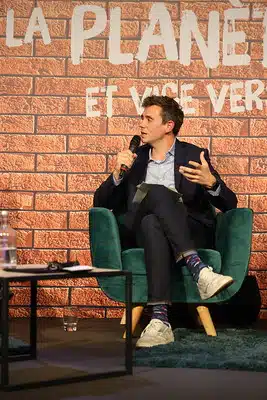Dr. Carmen Hijosa, the founder of Ananas Anam Ltd, was presening in this afternoon’s conference on “getting the circular economy rolling”. This innovative and ethical entrepreneur created Piñatex, a natural textile made from pineapple leaf fibre. She exposed her vision for a more sustainable future that connects people, the environment and the economy. Her company has received awards for being the most innovative in circular economy, following an international call for projects convened by the EU-LAC, InnivationAL and Reseau Alliances.
What does it mean for you to be part of this 12th edition of the WFRE?
It is the first time that me coming to the World Forum and it has been wonderful. Being part of this conference on the circular economy was very interesting. This way of economy is what I truly believe in.
Seeing examples of ideas from different parts of the world is truly inspiring. I think that sharing all those point of views is what makes our economy stronger. This World Forum is an inspiration for all of us: it is exciting to be part of it.
Do you think it is possible to expand your model in other parts of the world?
Absolutely, that is the whole idea. We made a pilot model in Philippines and once it will be fully developed, we can transfer all this knowledge into any other country growing pineapples. Those tropical countries are usually quite poor. So, this can really bring forth a revolution and would help those countries to reuse waste and create jobs. So, definitely.
Are leather companies ready to make a change in their material in order to be more sustainable?
A couple years ago, I went to see the leather companies. I wanted to work with them, but they thought the project was absurd. It was not possible to start the conversation as they did not perceive leather as a problem in itself. But now, it is starting to change. People are more and more aware that the leather is not sustainable and know that alternatives exist.
Two weeks ago, during the Première Vision event in Paris, a leather company came to us. They told us that they are facing new challenges especially with the fact that leather is not sustainable and they cannot find a solution. That is a first step. So, there is a very interesting shift.
How do you see the future?
I see the future as very good and bright. As I said, it is necessary to focus on our waste than looking for new resources. We can do so much with our waste. I have hundreds of new ideas in mind. Now, we must keep on going and develop new products based on reused materials. The future is in the cycle of use and circular economy. This is what we need to believe in.
In our societies, we do not think enough. But there is a solution, there are alternatives in front of us. We just need to think. Before we buy something, we must ask ourselves the question: Do I need this? Why? Is it sustainable? We need to be more responsible about the environment, the economy, the people. Because now more than ever, it is more than a necessity: it is an emergency.
Delphine HENNEGUELLE



